Homemade Sourdough Bread, Step by Step
This post may contain affiliate links. Please read my disclosure policy.
If you love fresh sourdough bread with a golden, crisp crust and a light, airy crumb, this recipe is for you. It’s one of the simplest homemade sourdough bread recipes, and one of the best, too. It requires only 25 minutes of hands-on work and no autolyse or preferment. Below you will find guidance for every step of the way. 🍞🍞🍞
⭐️⭐️⭐️⭐️⭐️ Review:
“Absolutely the best sourdough recipe EVER! I have been baking bread for years (sourdough included,) and things were many times hit or miss. Not with your recipe. You have nailed it. I thank you!” — Rosemary Patterson

This post will show you how to make the simplest of simple sourdough breads. There is no autolyse or preferment, which means the dough itself comes together in less than five minutes.
For those intimidated by sourdough bread baking, this recipe, as well as this sourdough focaccia recipe, are the recipes I suggest making first, both for their simplicity and flavor. Another great beginner’s bread recipe to try is this overnight, refrigerator focaccia or my mother’s simple peasant bread recipe, both of which require minimal effort but yield spectacular results.
This post is divided into 13 sections:
- What is Sourdough Bread?
- What is a Sourdough Starter?
- How to Feed a Sourdough Starter
- When is My Starter Ready to Be Used?
- Equipment
- How to Make Sourdough Bread: A 5-Step Overview
- How this Sourdough Bread Recipe Differs From Others
- Simple Sourdough Bread: A Step-by-Step Guide
- #1 Sourdough Bread Baking Tip
- Troubleshooting: Where Sourdough Goes Wrong
- Sourdough Baking Resources
- Other Sourdough Bread Recipes to Make
- Sourdough Bread Baking Schedule
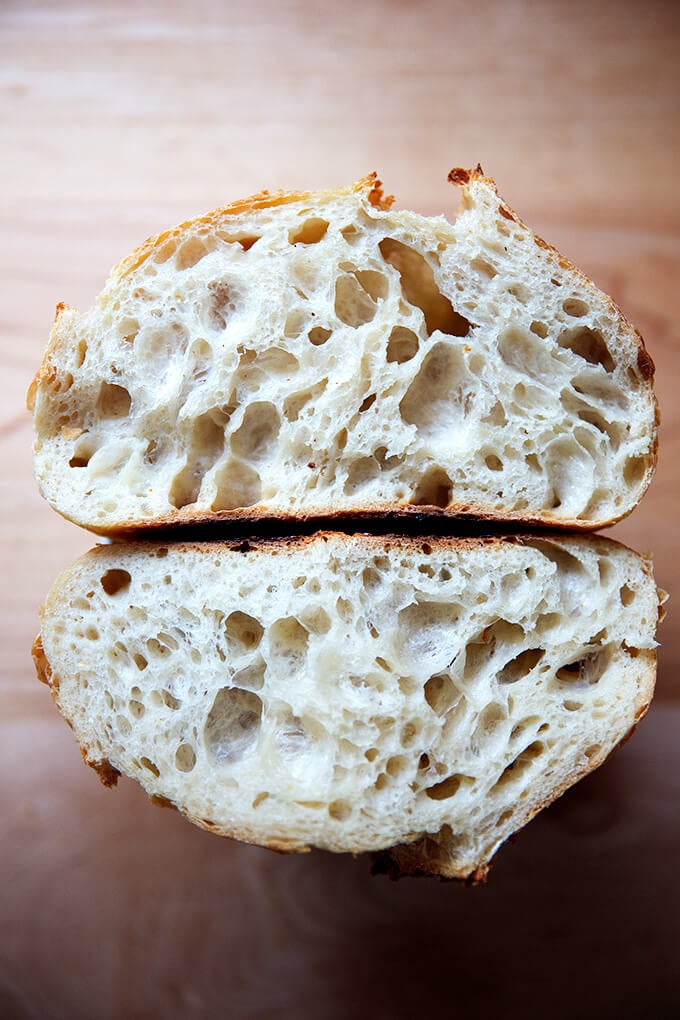
What is Sourdough Bread?
Sourdough bread is bread that has been leavened naturally, meaning it has been leavened by a sourdough starter as opposed to by commercial yeast or a chemical leavening agent such as baking powder or baking soda.
What is a Sourdough Starter?
A sourdough starter is a fermented mix of flour and water containing wild yeast and bacteria (lactobacilli). Provided it is healthy and active, a sourdough starter is what will make your bread rise.
You can make a sourdough starter from scratch in just about a week. I only recommend doing so if it currently is summer (or a very warm fall) where you are. While it is immensely satisfying to build a starter from scratch and subsequently use it to make a beautiful loaf of bread, I am a huge proponent of purchasing one for a few reasons, namely: when you purchase a starter, you are guaranteed to have a strong, vigorous starter from the start. In other words, you can start baking with confidence right away.
Here are three online sources for reasonably priced sourdough starters:

How to Feed a Sourdough Starter
In order to keep your starter alive, you have to feed it — it’s not unlike having a pet, but know this: caring for a sourdough starter is akin to caring for a very low maintenance pet, one that requires feeding only once every two to three weeks to stay alive, but one that requires feeding much more regularly if you like to bake frequently.
When I am not baking regularly, I store my starter in the fridge in the above-pictured vessel with its lid on. As noted above it can hang out there for 2-3 weeks (if not longer) without being touched. To wake it up or activate it, I like to feed it twice before using it. Often I’ll remove it from the fridge after dinner and feed it: this involves discarding most of it and replenishing it with equal parts by weight flour and water. (Please read this post, which explains in detail how to activate, feed, and maintain a starter.)
I will repeat this process in the morning — discard most of it; then replenish it with equal parts by weight flour and water. By midday, or when my starter has doubled in volume, it is ready to be used.
To store your starter, you should feed it, let it rise till it nearly doubles; then cover it and stash it in the fridge for 2 to 3 weeks until you are ready to use it again.
How Do I Know if My Starter is Ready to be Used?
If your starter doubles (or triples!) in volume within 4 to 8 hours after a feeding, it is ready to go. And ideally, you want to use your starter 4 to 8 hours after you feed it or when it has doubled. Every time I feed my starter, I place a rubber band around the vessel it is in to mark its height. This helps me see when it has doubled in volume and is, therefore, ready to be used.
If your starter is not doubling within 4 to 8 hours of feeding it, you should spend a few days strengthening it. This will involve discarding most of it — truly, don’t be afraid to be aggressive with how much you are discarding — and replenishing it with equal parts by weight flour and water. If you do this twice a day for several days, your starter will be in great shape.
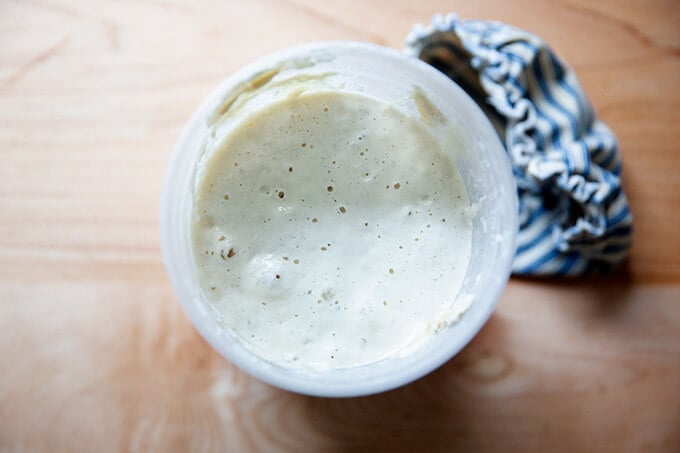
What Equipment Do I Need?
At a minimum, you’ll need:
- a sourdough starter (see above)
- flour, bread flour if possible, my preference is King Arthur Flour
- salt
- water
Ideally, you’ll also have:
- digital scale
- straight-sided vessel for monitoring the bulk fementation
- bench scraper
- flour sack towels
- parchment paper
- banneton, such as this one or this one
- razor blade
- heavy lidded vessel, such as this one or this one
How to Make Sourdough Bread: A 5-Step Overview
There are essentially 5 steps to making sourdough bread. Each of these steps is explained in more detail below.
- Mix the Dough: This is simply a matter of combining water, sourdough starter, salt and flour in bowl, and stirring to form a sticky dough ball.
- Bulk Fermentation: This is just a fancy name for the first rise. During the first two hours of the bulk fermentation, you’ll perform a series of stretches and folds, which will give the dough strength and elasticity.
- Shape + Bench Rest: This step ends the bulk fermentation. You’ll shape the dough, let it rest, then shape it once more.
- Proofing the Dough: In this recipe, you’ll cold proof the dough in the fridge, ideally for 24 to 48 hours, though you can get away with a shorter proof.
- Scoring + Baking the Dough: After the dough has proofed, you’ll turn it out onto a piece of parchment paper, score it; then transfer it to a preheated baking vessel.
How This Sourdough Bread Recipe Differs From Others
This recipe differs from others in three main ways:
- No Autolyse. Why? I’ve never found employing an autolyse makes a big difference in the final texture of the bread, and I find the process of doing an autoylse frankly to be kind of a pain. What is an autolyse? Autolyse is a technique that calls for mixing flour and water together and allowing them to sit for several hours before adding the salt and sourdough starter. This process allows gluten to develop in dough prior to mixing. It also makes the dough more extensible. This is due to the hydrating effects of soaking the flour, as well as — and this is getting a bit scientific — from the enzymatic activity of protease, which breaks down some of the gluten that forms as the dough hydrates. This process weakens the dough’s elasticity, in turn increasing its extensibility. If you are after a super open crumb, autolyse is something to consider.
- 50% (roughly) Increase in Volume. If you come from the yeast-leavened bread world, you are accustomed to letting your dough double in volume during the first rise. When I first got into sourdough, I was applying this same method, and while I had success, I realized I was often letting my dough overferment — I was pushing the bulk fermentation too far. As soon as I stopped the bulk fermentation when the dough increased by 50-75% in volume, I got a much better oven spring.
- Long Cold Proof. After the bulk fermentation, you’ll shape the dough, and store it in the fridge ideally for 24 hours but it can hang out there for 48 hours or even a bit longer. This long, cold proof will make for a much lighter, open, airy crumb. (Note: If you were to leave the dough in the fridge for 12 hours or less, which you can do, the crumb will be tighter and denser.) After you remove the dough from the fridge, you score it, and transfer it immediately to the oven — there is no need to do a room temperature proof first.
Simple Sourdough Bread: A Step-by-Step Guide
Mix the dough.
To start, pour 375 grams of water into a bowl:

Add 50 to 100 grams of sourdough starter.
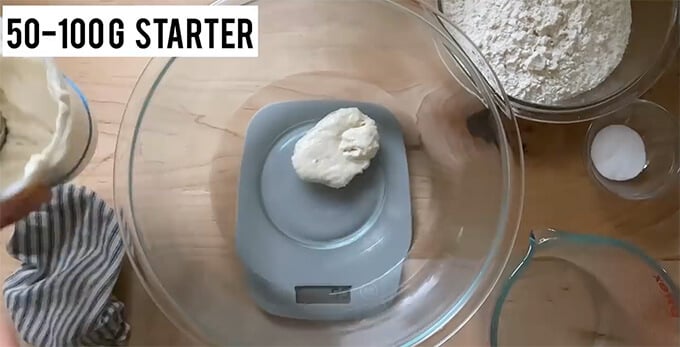
Stir to combine; then add 11 grams of salt:
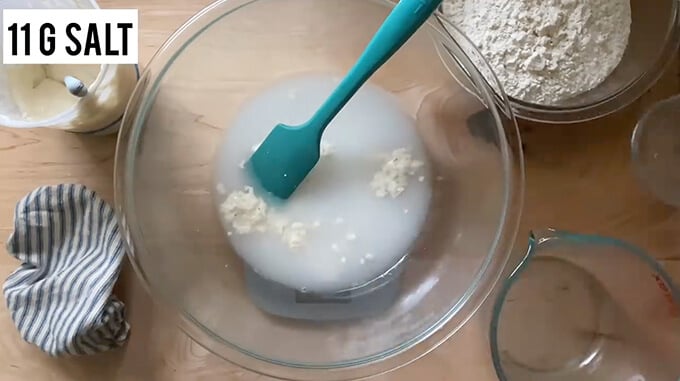
Finally, add 500 grams of bread flour:

Stir to combine:
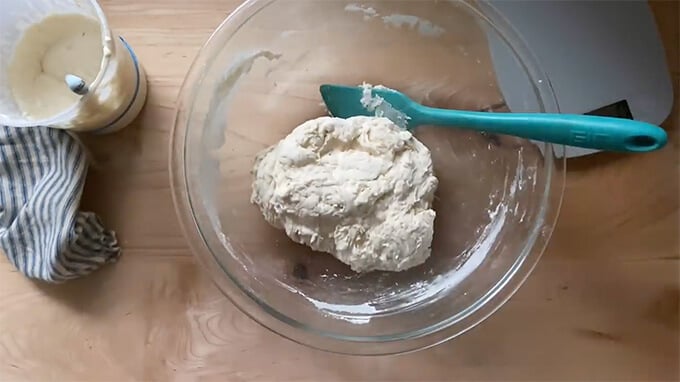
Let it Rise. (Bulk Fermentation)
Transfer the dough to a straight-sided vessel. Cover it, and let it rest for 30 minutes.
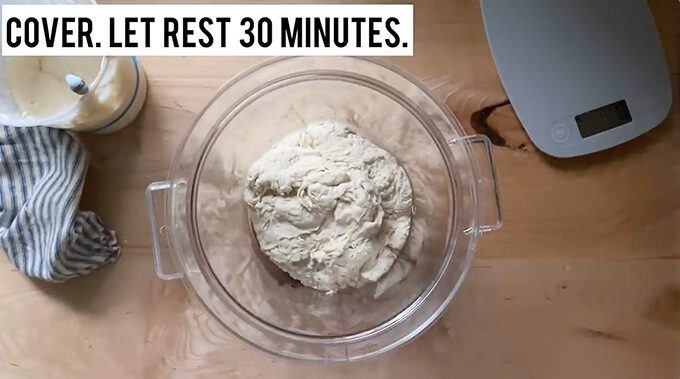
Perform a set of stretches and folds:
If time permits, perform four total sets of stretches and folds every 30 minutes for the first 2 hours. You should notice the dough getting stronger and more elastic with every set of stretches and folds. This is the 4th set:
After the 4th set of stretches and folds, cover the vessel — I love these Dot and Army cloth bowl covers for this — and set it aside until it increases in volume by 50% or so.
How long should the bulk fermentation take?
The time will vary depending primarily on the strength of your starter and the temperature of your kitchen. Rather than rely on a time period, however, you should rely on visual cues.
This video shows the dough nearly doubling (increasing by 100%) in volume, but the more I bake sourdough, the more I realize I have better success when I stop the bulk fermentation when the dough increases by 50%. It may take some trial and error to know what works best for you. You may find a 75% increase in volume is best or you may find that to be too long. Sourdough is all about experimenting and adapting based on your experiences.
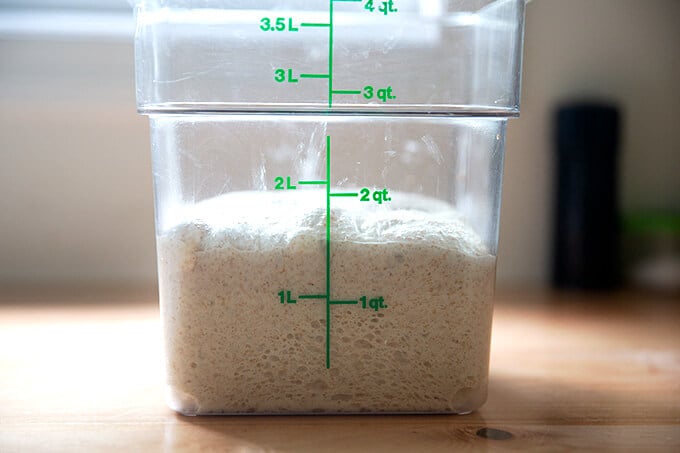
Shaping
Turn the dough out onto a lightly floured work surface:
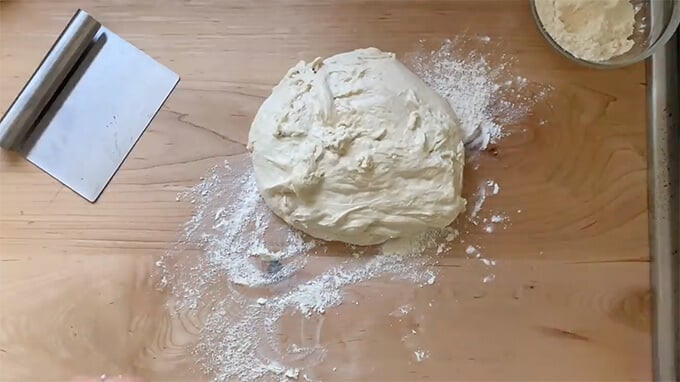
Shape the dough gently into a round and let it rest for 20-40 minutes. This is called the bench rest.
Meanwhile, prepare a bowl or banneton with a flour sack towel and rice flour.
Proofing
Shape the round again; then place in prepared bowl for proofing. Transfer to fridge for 12 to 48 hours.
Bake It.
Remove bowl from fridge, and turn it out onto a sheet of parchment paper.
Score it.
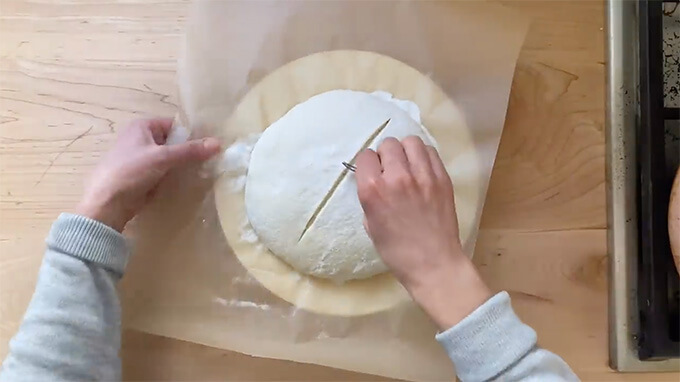
Transfer to preheated Dutch oven. Bake covered at 450ºF for 30 minutes; uncover, lower the temperature to 400ºF, and bake for 15 minutes more:

Remove from oven and let cool one hour before slicing.
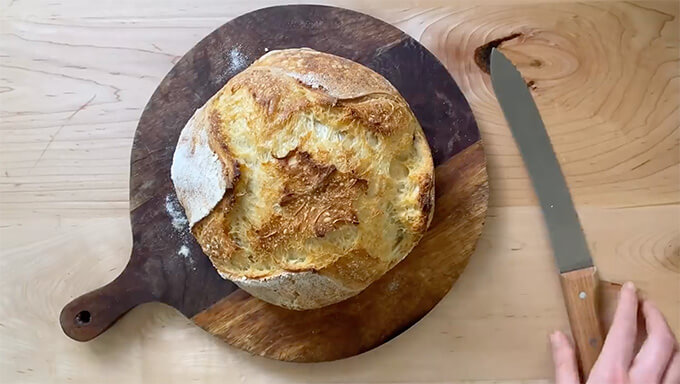
You’ll need a sharp knife (like this one or this one) when it’s time to slice:
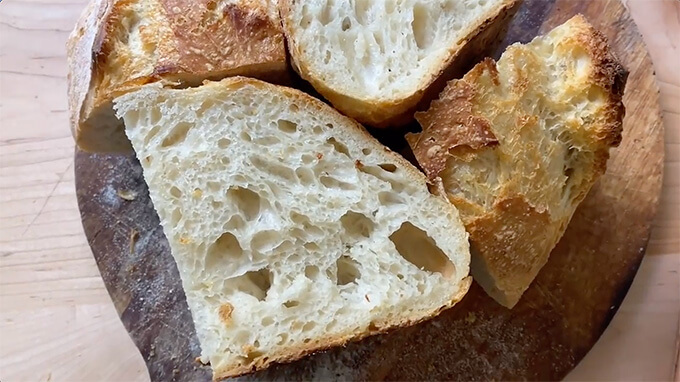
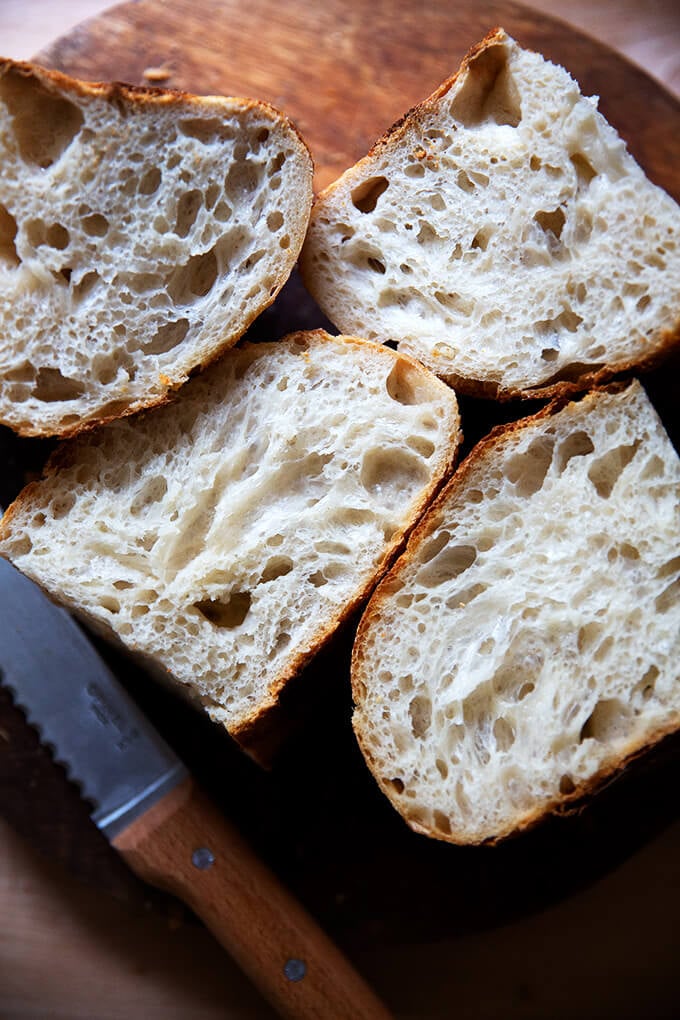
#1 Sourdough Bread Baking Tip
The refrigerator is your friend. Use it.
The most common mistake I see people make when making sourdough bread is letting the bulk fermentation go too long. They mix the dough at night; then wake up to dough that has tripled in volume and is a sticky mess.
To prevent over fermenting your dough, use your refrigerator as needed. After you complete the 4 sets of stretches and folds, you can put your dough in the fridge at any time. If you are tired and need to go to bed, transfer the dough to the refrigerator; then pick up where you left off in the morning: remove the dough from the fridge and let it continue to rise until it increases in volume by roughly 50%.
To accurately gauge when your dough has risen to roughly 50% in volume, I highly recommend investing in a straight-sided vessel such as this 4-qt Cambro (or this one, which is BPA-free!). When dough rises in a bowl, judging when it has risen sufficiently is tricky. There’s no question with a straight-sided vessel.

Troubleshooting: Where Sourdough Goes Wrong?
If you have ever had trouble baking sourdough bread, your issues likely stem from one of four places:
- Using a weak starter or not using starter at its peak.
- Using too much water relative to the flour.
- Over fermentation: letting the bulk fermentation (first rise) go too long.
- Using too much whole wheat flour, rye flour, or freshly milled flour.
I address each of these issues in this post: Why is my sourdough so sticky? 4 Common Mistakes, so please give it a read if you’ve had trouble with sourdough bread baking.

Sourdough Resources
- Sourdough Troubleshooting: This post addresses 4 common mistakes people make when baking sourdough bread and answers many FAQ’s as well.
- The Nutritional Benefits of Sourdough Bread + 6 Healthy Toast Topping Ideas
- Feeding Your Sourdough Starter
- Essential Equipment For Sourdough Bread Baking
- A tip for getting a more open crumb? Shape a batard as opposed to a round:
Other Sourdough Bread Recipes to Make
- Simple Sourdough Focaccia
- Sourdough Bread, Whole Wheat-ish
- Simple Sourdough Pizza
- Sourdough Detroit-Style Pizza
- Simple Sourdough Sandwich (or Toasting) Bread
- Sourdough Ciabatta
- Two Sourdough Discard Recipes: Sourdough Flour Tortillas & Irish Soda Bread
Sourdough Bread Baking Schedule
If you are new to sourdough bread baking, the timing of it all may feel overwhelming — you may find yourself asking: How can I do this without baking at midnight?
It’s a very good question! As noted above, your biggest friend when it comes to sourdough bread baking is your refrigerator. If after you’ve performed your stretches and folds, you don’t have time to stay up for the dough to complete the bulk fermentation, stick the vessel in the fridge and pick up where you left off the next day or the day after that.
Here is a rough schedule I like to follow. Adapt it to work for you:
Wednesday Evening: Remove starter from fridge. Feed it by discarding most of it and replenishing it with equal parts by weight flour and water.
Thursday Morning: Feed starter by discarding most of it and replenishing it with equal parts by weight flour and water.
Thursday Afternoon: Mix dough, let it rise. On Thursday evening, when the dough has completed the bulk fermentation, I’ll shape it and stick it in the fridge to proof. (As noted: If the dough hasn’t completed the bulk fermentation, I’ll stick the vessel in the fridge, and pick up where I left off the following day.)
Friday Evening or Saturday Morning: Score and Bake it. There is no need to let the dough come to room temperature before baking it. Simply remove it from the fridge, turn it out, score it, and bake it!
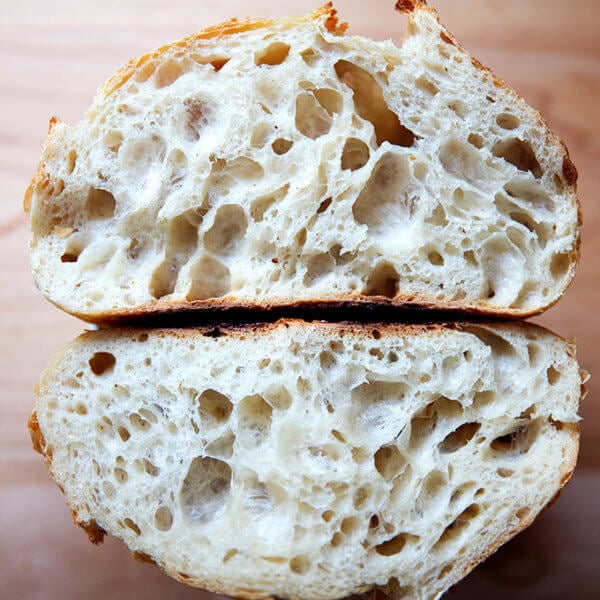
Homemade Sourdough Bread, Step by Step
- Total Time: 18 hours 45 minutes
- Yield: 1 loaf
Description
Inspired by The Clever Carrot
If you are new to sourdough, watch the step-by-step video here: Simple Sourdough Bread or in the post above.
Troubleshooting: If you have issues with your dough being too sticky, please read this post: Why is my sourdough so sticky? The 4 common mistakes.
Notes:
- You need an active sourdough starter. I have had success activating starters from:
- As always, I highly recommend investing in a digital scale before beginning any bread baking adventure.
- This is the Dutch Oven I use for sourdough bread. I used this Dutch oven for years, and it’s a great one, too.
- Flour sack towels are a great investment because they ensure your dough will not stick while it is proofing.
- I love using rice flour for dusting (as opposed to ap or bread flour) because it doesn’t burn. When you use a flour sack towel, however, you don’t need to use any flour.
- Find all of my sourdough essentials here: Essential Equipment For Sourdough Bread Baking
- I love a high-hydration dough, and I have great success using 380 grams of water in this recipe, so feel free to play around and push the hydration here.
- Salt: I have had success using both kosher salt and fine sea salt here. When I use kosher salt, I use the Diamond Crystal brand. When I use sea salt, I use the Baleine Fine brand. Regardless of the brand, I use 12 grams.
- Shaping: If you’re looking to get a more open crumb, try shaping a batard (as opposed to a round). Watch this video for guidance. Also: The recipe below follows the traditional shape once, rest, then shape again method. I often skip the preshape now and simply shape the dough once. I still get a nice open crumb.
How much Sourdough Starter to Use?
- Because my kitchen is cold for much of the year, I like using 100 g (1/2 cup) of starter as opposed to 50 g (1/4 cup). When determining how much starter to use, consider a few things: If you live in a warm, humid environment, 50 g should suffice. If you plan on doing an overnight rise, 50 g also should suffice. If you want to speed things up or if you live in a cold environment, consider using 100 g starter. Note: If you use 100 g of starter, your dough may rise more quickly, so keep an eye on it. As always, rely on the visual cues (increasing in volume by 50%) when determining when the bulk fermentation is done.
- A straight-sided vessel makes monitoring the bulk fermentation especially easy because it allows you to see when your dough has truly doubled.
Ingredients
- 50 – 100 g (1⁄4 – 1/2 cup) bubbly, active starter — I always use 100 grams, see notes above
- 375 g (1 1/2 cups plus 1 tbsp) warm water, or more, see notes above
- 500 g (4 cups plus 2 tbsp) bread flour
- 9 to 12 g (1.5 – 2.5 teaspoons) fine sea salt, see notes above
Instructions
- Make the dough: Whisk the starter and water together in a large bowl with a fork or spatula. Add the flour and salt. Mix to combine, finishing by hand if necessary to form a rough dough. Cover with a damp towel and let rest for 30 minutes.
- Stretch and fold: After 30 minutes, grab a corner of the dough and pull it up and into the center. Repeat until you’ve performed this series of folds 4 to 5 times with the dough. Let dough rest for another 30 minutes and repeat the stretching and folding action. If you have the time: do this twice more for a total of 4 times in 2 hours. Note: Even if you can only perform one series of stretches and folds, your dough will benefit. So don’t worry if you have to run off shortly after you mix the dough.
- Bulk Fermentation (first rise): Cover the bowl with a towel and let rise at room temperature, about 8 to 10 hours at 70°F (21°C) or even less if you live in a warm environment. The dough is ready when it has increased by 50% in volume, has a few bubbles on the surface, and jiggles when you move the bowl from side to side. (UPDATE: In the past I have recommended letting the dough rise until it doubles in volume. If you’ve had success with this, continue to let the dough double. Recently, I have been stopping the bulk fermentation when the dough increases by 50% in volume, and I feel I am actually getting better oven spring in the end.) (Note regarding timing: If you are using 100 g of starter, the bulk fermentation may take less than 8 to 10 hours. If you live in a warm, humid environment, the bulk fermentation may take even less time. In the late spring/early summer, for example, my kitchen is 78ºF and the bulk fermentation takes 6 hours. It is best to rely on visual cues (increase in volume by roughly 50%) as opposed to time to determine when the bulk fermentation is done. A straight-sided vessel makes monitoring the bulk fermentation especially easy because it allows you to see when your dough has truly increased in volume by 50%.)
- Shape (See notes above): Coax the dough onto a lightly floured surface. Gently shape it into a round: fold the top down to the center, turn the dough, fold the top down to the center, turn the dough; repeat until you’ve come full circle. If you have a bench scraper, use it to push and pull the dough to create tension.
- Rest: Let the dough rest seam side up rest for 30 minutes. Meanwhile, line an 8-inch (20-cm) bowl or proofing basket with a towel (flour sack towels are ideal) and dust with flour (preferably rice flour, which doesn’t burn the way all-purpose flour does). Using a bench scraper or your hands, shape it again as described in step 4. Place the round into your lined bowl, seam side up.
- Proof (second rise): Cover the dough and refrigerate for 1 hour or for as long as 48 hours. (Note: I prefer to let this dough proof for at least 24 hours prior to baking. See video for the difference in the crumb of a loaf that has proofed for 6 hours vs one that has proofed for 24 hours. If you choose to proof the dough in the fridge for an extended period of time, you may want to tuck it into a loosely tied bag — produce bags from the grocery store are great for this purpose — to ensure the dough does not dry out. The original recipe calls for a 1-hour rise, and if you have had success doing that, by all means, keep doing it.)
- Place a Dutch oven in your oven, and preheat your oven to 550°F (290°C). Cut a piece of parchment to fit the size of your baking pot.
- Score: Place the parchment over the dough and invert the bowl to release. Using the tip of a small knife or a razor blade, score the dough however you wish — a simple “X” is nice. Use the parchment to carefully transfer the dough into the preheated baking pot.
- Bake: Lower the oven to temperature to 450ºF (230ºC). Carefully cover the pot. Bake the dough for 30 minutes, covered. Remove the lid, lower the temperature to 400ºF (200ºC) and continue to bake for 10 – 15 minutes more. If necessary, lift the loaf out of the pot, and bake directly on the oven rack for the last 5 to 10 minutes. Cool on a wire rack for 1 hour before slicing.
- This loaf will stay fresh up to 3 days stored at room temperature in an airtight plastic bag or container. It freezes beautifully, too.
Notes
- This recipe has been adapted from Artisan Sourdough Made Simple. Changes I have made to the original recipe include:
- Using 11 g salt as opposed to 9 g.
- Performing 4 stretch and folds during the first 2 hours of the bulk fermentation, which build strength in the dough.
- Doing a cold proof for at least 24 hours before baking, which produces a lighter airier crumb. In the video, you can see the difference between the crumb of a loaf that has proofed for only 6 hours vs a loaf that has proofed for 24 hours.
- Finally, I like preheating my Dutch oven, which makes a crisper crust.
- Prep Time: 18 hours
- Cook Time: 45 minutes
- Category: Bread
- Method: Oven
- Cuisine: American
This post may contain affiliate links. Please read my disclosure policy.






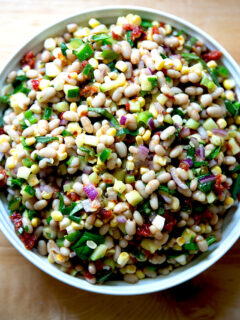
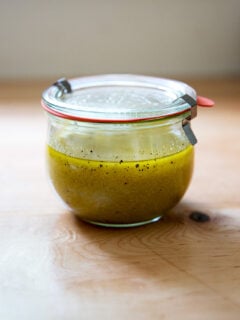








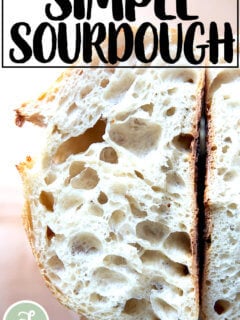
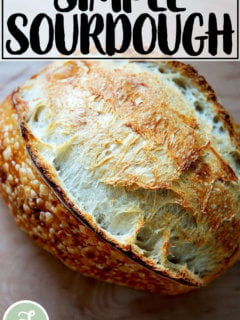

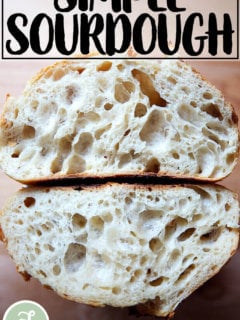
3,032 Comments on “Homemade Sourdough Bread, Step by Step”
This is a great recipe. I would like to bake two loaves, one to kelp and one to go e it away to friends.If I double the ingredients, when in the process should I split the loaf in half?
Great to hear, Sam! Split it right after the bulk fermentation 🙂
My very first sourdough starter and bread, and I do not know how I could’ve made it this far in life without it! I was really intimidated even by the idea of sourdough, but this recipe was so detailed and easy to follow. I did not believe it till I cut it. It was hard to wait an hour, but once I had the first bite of it ALL of it was worth it! Thank you so very much for sharing this recipe, and making me fee like a real baker. My family lives on the sourdough for years, and when we’re out of it it’s not a good day! But, I am confident to say this was the tastiest bread I’ve ever had. In the past 4 days I’ve made 3 loaves and we all are very pleased. But I need help; I want to double the size of it, I have all the dishes/supplies and am wondering if I should just double the ingredients and how to bake it. I appreciate you so very much for what I have already accomplished and in advance for your answer.
So nice to read all of this, Siba! If you double the recipe, simply follow the same instructions, but split the dough in half after the bulk fermentation. Let me know if you have any other questions.
This is a VERY good recipe. The best sourdough recipe i’ve tried by far. Thank you so much for sharing it ❤️
Great to hear, Ruth! Thanks for writing 🙂
My Dutch oven is only rated to 500. (Lodge enameled Dutch oven) is it ok to just preheat to that?
Yes!
If making 2 loaves out of your recipe, how long to cook for?
Reduce the baking by 5 minutes at each phase (covered and uncovered).
OMG! I was so nervous trying to make my FIRST sour dough loaf, but Ali’s instructions were SO clear. She walks you through every single step both in the printed word and in the video. I actually squealed when I cut my bread open and said to myself “I can’t believe I did that!” Thank you Ali!! I’ll be sharing this recipe, for sure! (I have a video if you would like it.)
Awwww so nice to read all of this! Thanks so much for writing and sharing 🙂 🙂 🙂
I am new to sourdough but am loving it! There is so much to know!!!! Why did you place your newly made dough in a different ‘vessel’. I usually leave mine in the bowl it was mixed in.
Thanks for this great video.
Hi! I like the straight-sided vessel bc it helps me see how much the dough has truly grown in volume.
Hi! I really want to make this recipe, yet my oven unfortunately will not heat to 550 degrees (the max is 500), is there anyway I can alter the baking time so that my bread will bake with this temp?
500 is fine! Go for it 🙂
I’m new to making sourdough and have tried a bunch of recipes. This has by far been my favorite! I do 15g of salt instead of 12 though.
Great to hear, Lindsay! And I’m always down with more salt 🙂
I’ve been making sourdough for a few years now and this week was my first time using this recipe and it’s given me the best bread I’ve ever baked! I will definitely be using it again!
Great to hear, Janika!
This is a never fail recipe! I have made it many times. Can you please tell me how to make it into a whole wheat honey sourdough bread? Thank you!
Hi! I would sub in no more than 25% whole wheat flour for an equal amount of the bread flour. And you can add as much as 2 tablespoons honey.
I’ve been wanting, but too scared of trying, to make sourdough bread for years. It always seemed like way too much work and time than I was willing to give.
Then, a friend of mine gave me a starter. It still took me over a month even with the starter to try it, but I looked for a recipe that seemed somewhat easy to follow and found this one.
Wow! I’ve made 4 loaves so far and each one has been a little different. The first one, I totally missed the 8-10 hour proof at room temperature. Ha!! But it still turned out good. It was more French bread tasting than true sourdough, but it was still yummy. The next try, I read more carefully and followed the directions and the bread turned out so good!
Each time I make it, I try a little different timing to see how the bread turns out. I found that less time in the fridge made for a softer crust, but still delicious.
I am realizing that all my years of fear were for not; you can’t really mess up this sourdough bread. It’s flour, water and salt. Hard to truly make a loaf you cannot eat. It may not look as pretty, but it will still taste great. I don’t weigh my ingredients, nor am I someone who measures for exact amounts, and if my bread is coming out this good, then this recipe is THE RECIPE to follow!!
Thank you for taking my fear away and allowing me to enjoy home baked sourdough bread!
So nice to read all of this, Sue! Thanks for taking the time to write and share all of these notes. So helpful, encouraging, and inspiring for others to read this!
Hi. How could I shape into an oval banneton instead of a round one?
Hi! I have a shaping video here: https://www.youtube.com/watch?v=ZUz_X0xiRr0
I recently got into sourdough bread making, and this is maybe the 3rd or 4th recipe I’ve tried. This recipe produced the best bread I’ve made so far — thank you! The videos illustrating each step were very helpful.
Great to hear, Esther! Thanks for writing 🙂
This turned out perfect. The video was a great help. Wish I could send pictures
Great to hear, Carla! Thanks for writing 🙂
Help! It was looking perfect at the mark where I take off the lid, but the instructions said to cook for another 10-15 mins after lowering the temp and when I did it still burnt! Is it ok to take it out as long as it reaches 1900?
Yes, you can rely on the visual cues, and you can also take it out of the Dutch oven and bake it directly on the racks or on a sheet pan, which might be cooler than your Dutch oven. Does your oven typically run hot?
My oven can be really unpredictable so I usually just gauge my bread by it’s internal temp. All the other breads I cook to 190°F but because this is my first time playing with sourdough, I’m unsure if it’s internal temp is supposed to be different! I made a second batch this morning on a bread stone which I didn’t burn but it was a little undercooked, little too chewy at the bottom, even tho it was brought to 190°. Any tips on making sure it’s done, or do you know what the internal temp should be? Maybe third time will be the charm!
Internal temp is a great way to do it especially if you have an unpredictable oven! I shoot for 205ºF with all of my breads.
Hi Ali – how long do you need to take the dough out of the fridge before baking? Does it need to come to room temp?
No time! It can go straight from the fridge to the oven.
Love the simple instructions and I made successfully the best bread I ever made 🙂
Great to hear Jhunu!
Can I wait longer thann30 mi utes between stretch and folds.
I have made this bread 4 times and it is fabulous!
Yep! It’s very forgiving in this regard — you can wait an hour or longer… whatever your schedule permits.
hi! would it work if I wanted to swap some of the flour with a whole-wheat flour? if I kept 50 or 60% bread flour and 40% whole wheat? thank you!
Yes! Just keep in mind the texture will be more dense. Stilly tasty, just not as light and airy.
Amazing! Followed to the letter and have had huge success. Appreciated all the detail, including the troubleshooting and alternative options for different climates. Despite being brand new into this sourdough journey, I have yet to have a complete flop. As much as I would like to attribute that my own baking skills 😉 I know your recipe is the real win. Thank you.
P.S. any idea if you could substitute in a gluten free sourdough starter and gluten free flour with this recipe and process? Or any good recommendations? A lot of gluten free recipes aren’t looking…worthy (at no fault to the other bakers…just the lack of wheat I’m sure). My gluten free sourdough starter is ready to go, but haven’t come across a decent enough recipe yet 🙂
Great to hear Lindy! Thank you 🙂
Regarding your gluten-free question, since you have your starter ready to go, I might consider using that in place of the yeast in this recipe: Gluten-Free Peasant Bread Recipe. It’s a different vibe than this crusty sourdough bread recipe, but it might be a good place to start.
If you are looking for more, there is a woman named Aran Goyoaga who wrote a book about gluten-free sourdough bread. She’ll be a great resource!
Made my first ever sourdough using your instructions. Thank you!!! It’s delicious and I can’t wait to make my next loaf. Wish I could send you a photo!!
So nice to hear, Louise! Thanks so much for writing 🙂 🙂 🙂
Priceless
The best loaf that I have ever baked I did modify your recipe a little bit but damn I can’t wait for 45 more minutes so I can cut into this 👨🍳
Ha! I get that. Thanks for writing 🙂 🙂 🙂
I had a really easy time understanding and following the recipe. I haven’t cut into the loaf yet, but the outside looks beautiful! This is the first loaf I have made that has risen correctly and has not turned into a flat dense disc loaf. Thank you for your recipe!
Great to hear, Kassy! Thanks so much for writing 🙂 🙂 🙂
Thank you for this recipe. I made it once and it turned out great! I plan to make it again, and I’m wondering if this will fit in a 9×5 pan?
Yes, it should! You could also make this recipe: Easy Sourdough Sandwich Bread
What if your recipe calls for 1- 2 cups starter?
Hi! Can you clarify your question? Do you want to use 2 cups of starter here?
What adjustments need to be made if i want to add olives and thyme?
You can add the thyme with the flour. Add the olives just before the third set of stretches and folds. No other changes!
I made the focaccia for the very first time and brought it to a Bunco gathering. (Admittedly I was nervous never having made any type of sourdough prior.) It was so delicious and was scarfed/up! I gave starters to my neighbors and they are now on the sourdough train:)